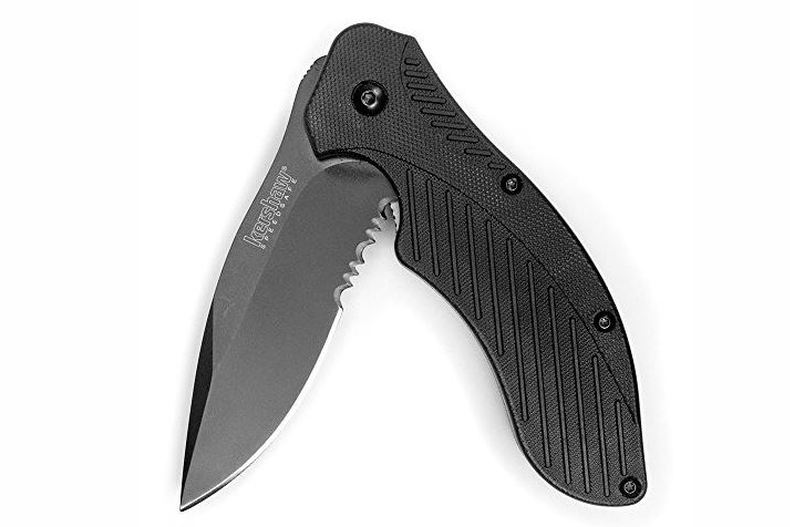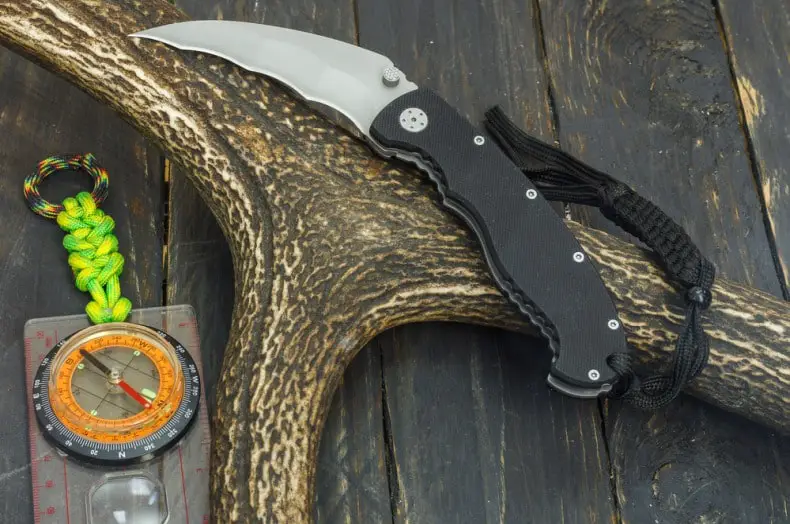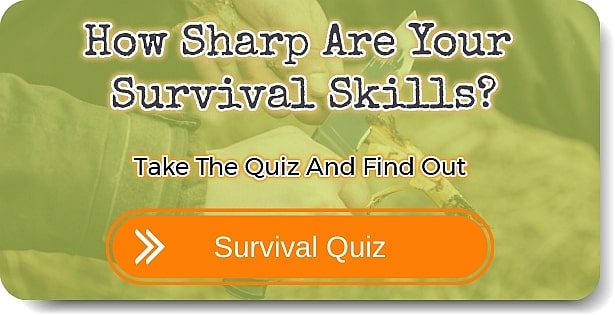When you have a knife, it is likely on your person for a load of different reasons. Yet one of the most important things people learn early on with a knife is how to be safe with one. Of course, we’re not unaware that knife safety is something that some simply never learned growing up.
Perhaps you did not have any knives around outside a kitchen or garage. Maybe you’re new to certain types of knives compared to the standard pocket knife we all seemed to have.
Side Note: Does it not seem odd that most of us can remember having small knives as just kids? What were our parents thinking, right?
In any case, knife safety is obviously very important when using your knife. However, the type of knife you have is critical to keep in mind, as there are different safety precautions to take somewhat between knife types.
Of course, there are also some obvious, universal safety measures too. Some safety stuff you may not be aware of as well. It’s good to learn about new things you could be doing to stay safe with sharp objects.
Without further delay, let’s dive into knife safety tips you need to know.
Table of Contents
5.) Use The Proper Knife For The Job It’s Intended

One of the most common mistakes people make with knives is that they try to use a knife for something it’s truly not cleared for. Just as an example of this, outdoor knives are not meant to be used in the kitchen even if you’ve cleaned them. The same for kitchen knives outdoors.
People who do this tend to get terrible results, as the knife use is misguided. You’re using something in a way that does not work. It’s like putting a square peg in a round hole. No matter what you do, how much jamming you attempt, the round hole is not made for the square peg.
You will not get the same success with a Paring Knife when using it for the needs of a Butcher Knife or Chef Knife. Yet the same is expected outdoors too. Imagine trying to use a random fixed blade knife to cut through wooded areas. It’s not going to work as well as a Machete.
Of course, on the flipside, Paring Knives are great for their own thing that a Butcher Knife would be bad at. Same for a Machete in cases where smaller, traditional fixed blades are more useful.
4.) How To Properly Hand A Knife To Someone Else
There are several ways to hand off a knife to someone else. However, there are different ways to do it in terms of the outdoor versus indoor concept. This will also be determined by the type of knife you’re handing off.
For a pocket knife, just fold up the knife portion and hand it to the person. This is simple enough, right? If you’re using a fixed blade, it’s best to hand it to them with the knife in its sheath. This will ensure that even if you dropped it on accident, no one is going to get hurt.
If you do not have a sheath, then you should grab the non-blade section of the knife and hand it to a person handle-first. This ensures they won’t get cut accepting the knife. As they take it, you’re not going to get cut. Never hand a cutting edge to someone.
Of course, some outdoor blades might have two double-edge sides. If that if the case, you should simply lay it on a flat surface near them where they can pick it up themselves. This too, ensures no one is cut.
In the kitchen, everything above is considered useful. However, the Health Department and OSHA state that you should always do the latter. Leave the knife near them handle-first if possible. The reason for this is two-fold.
For an outdoor knife, it typically does not matter if you touch the blade. Yet in a kitchen, you could leave germs on it or cross-contaminate even if you are wearing gloves. Therefore, by leaving the knife on a clean flat surface near another person….you are keeping the knife away from possible contamination AND you’re keeping both parties safe.
3.) Keep Your Knife (Knives) Sharp
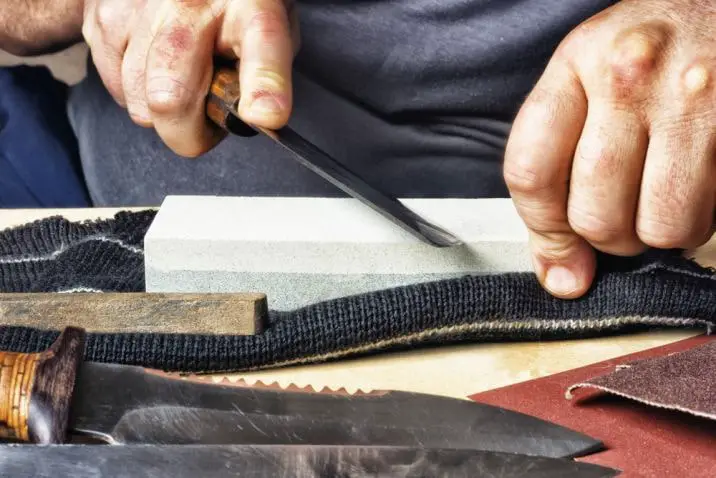
A sharp knife is a safe knife. One of the most commonly mistaken things in knife safety is that people just do not keep their knives sharp. This results in several problems. First, you’ll often work much harder to accomplish a task with a dull cutting edge. At this point, you’re using energy that isn’t worth it.
Second, a dull knife leads to some putting more pressure down. Sometimes, it’ll lead to people making wild cutting choices, which can all be unsafe. This is a good way to see injuries in the outdoors and especially in the kitchen.
Cuts are terrible to get for the person but both places are terrible places to get cut. For the kitchen, it presents a possible health hazard to the food being prepared as well as the place where future food will be prepared. For the outdoors, cuts can become infected.
Neither is good to see. Therefore, always keep the cutting edge of your knife or knives sharp and you’ll likely never experience anything like this. At least, that is the goal of a sharp knife. If it’s sharpened and still lacks a good ability to cut, get rid of that knife or those knives and invest in better ones.
2.) Cut Away From Your Body
It should be obvious that cutting toward your body can lead to numerous issues. However, some do not realize that this can be an issue. Remember, your knife is not a saw even if the cutting edge is serrated and looks kind of like one.
When you’re cutting something, you only go back and forth to the extension of the knife itself. You want to be away from the knife as best you can be with your elbow bending in and extending in a normal form. No further.
You want to put your index finger on the top of your blade with most pocket knives. If you have a good, long handle on a fixed blade then you want to hold your hand somewhere in the middle-top section of a blade when needed.
This will keep it down and prevent it from popping up and out at you. Yet you might need to have extra support or traction. You can do this by holding onto something away from the cutting area. By doing this, you’re not risking any possible cuts to your other hand by accident.
1.) Knife Safety For Crafting
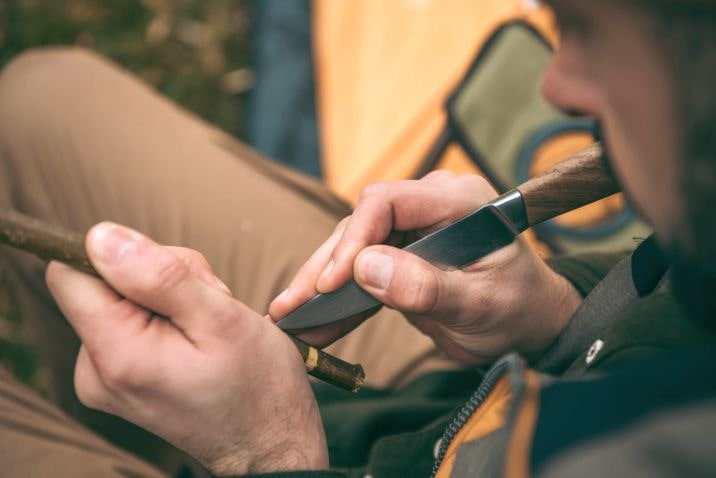
There are a few things you might do outdoors where knife safety will be of major importance to remember. This comes down to finer work and when you need to cut around an object. First, for finer work, you want to be sure you get your thumb on the back of the blade.
This will help for support and leverage with your wrist, rather than using the energy of your entire arm. While using your entire limb for things such as punching can be good, this is not the same with knives. Why? Using too much of the arm can lead to far too much power.
That can cause dangerous strikes off your cutting object and/or more serious accidents if something slips. You won’t be able to stop things as easily. By putting more on your wrist to handle, you save yourself from this danger.
Some knives actually have places for your index finger or thumb too.
Second, always keep a good tight grip on your knife. Never rotate your knife or your arm to cut something or shape it. You always want to rotate the object if possible. If you cannot move it, then you need to move around completely, always maintaining the same cutting movement, power, and positions.
This will not only ensure consistency in your cutting technique but it also helps you develop proper muscle memory as you work. Now, you can almost be on autopilot yet still keep to proper knife safety the entire time.




